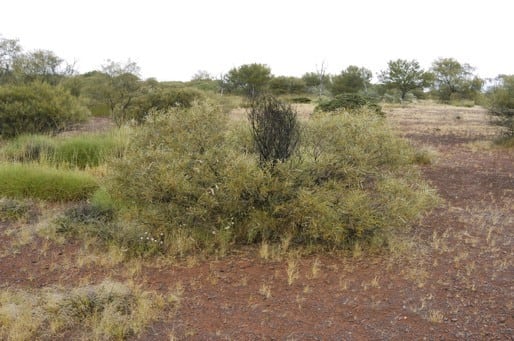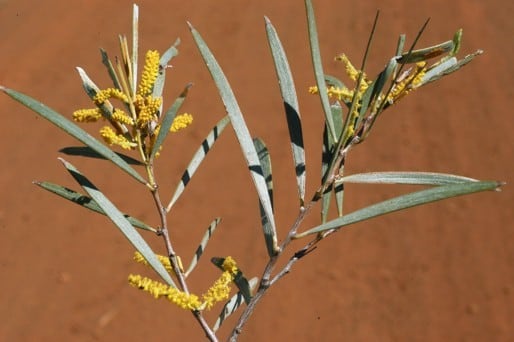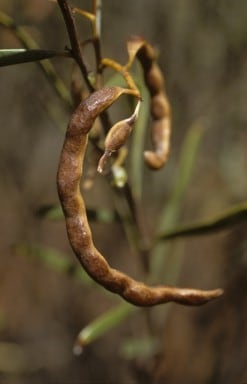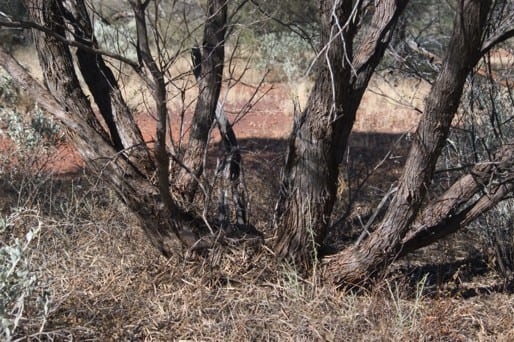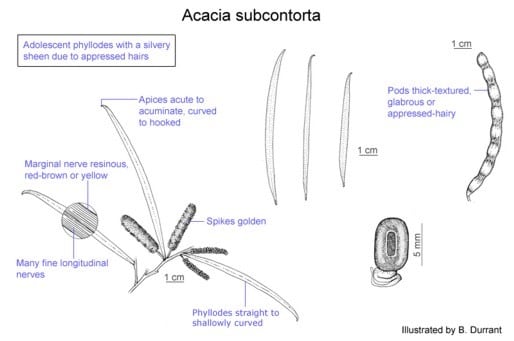Acacia subcontorta Maslin
WATTLE
Acacias of Australia
Family
Fabaceae
Distribution
Occurs in the Pilbara region, S to Lorna Glen Stn and E to the Gibson Desert, W.A., extending E into south-western N.T. and north-western S.A.
Description
Multistemmed shrub or tree (1–) 2–6 (–8) m high, with rather crooked trunks, the main branches somewhat contorted and ±horizontally spreading. Branchlets mostly glabrous. New shoots sericeous; hairs pale yellow aging silvery white. Phyllodes linear to very narrowly elliptic, straight to shallowly recurved, acute to acuminate with curved to uncinate tips, 6–11 cm long, (2–) 3–5 (–8) mm wide, coriaceous to sub-rigid, appressed-hairy to glabrescent, grey-green to bluish with silvery sheen, aging green; finely multistriate with numerous nonanastomosing nerves; margins resinous, red-brown or sometimes yellowish; gland inconspicuous. Inflorescences simple or sometimes rudimentary racemes to 2 mm long; peduncles 2–6 (–8) mm long, sparsely to densely appressed puberulous, sometimes glabrous when in fruit; spikes 2–3.5 cm long, densely flowered, golden; receptacle with sparse to moderately dense spreading white or pale yellow (rarely light golden) hairs but often glabrous when in fruit. Flowers 5-merous; calyx dissected to c. ½ its length. Pods narrowly oblong to linear, turgid to ±subterete, 1–7 cm long, usually 6–9 mm wide, coriaceous-crustaceous to woody, turgid to ± subterete, glabrous or with appressed (W.A.) or ±patent (N.T. & S.A.) white hairs. Seeds longitudinal, oblong to elliptic, 5–7 x 4–5 mm (W.A.) or 4–5 x 3–3.5 mm (N.T. & S.A.), dark brown to ±black; aril terminal.
Phenology
Flowers May–July.
Habitat
Often grows on hardpan plains in loam or sand, between mulga groves with limited spinifex.
Specimens
W.A.: between Thryptomene Hill and Mt Samuel on Gunbarrel Hwy, D.J.Edinger 106 (PERTH); Hamersley Range, ca 10 km due W of Giles point on Giles Rd, B.R.Maslin 8698 (DNA, MEL, NSW, PERTH). N.T.: 1 km E of Kulgera, P.K.Latz 5843 (BRI, DNA, NSW, PERTH). S.A.: Musgrave Ra., 12 July 1969, F.T.Turvey s.n. (AD, NSW, PERTH).
Notes
In good sites (i.e. along drainage lines) this species may attain arborescent stature 6 (–8) m high, but on drier sites it is more shrubby and 1–3 m high. These habit differences are probably related to the depth of the underlying hardpan.
One specimen from the Gibson Desert has atypically narrow pods c.4 mm wide (Desert Dreaming Expedition 174, PERTH).
Plants from N.T. and S.A. which were noted in Fl. Australia 11B: 307 (2001) under A. olgana are now provisionally referred to A. subcontorta but require further study. They differ most obviously from W.A. plants in some carpological characters (see description above). Acacia olgana differs most obviously in its green phyllodes with yellow, non-resinous margins, generally shorter peduncles and narrower, more thinly textured pods with smaller seeds. Acacia subcontorta is related to A. citrinoviridis which is most readily distinguished by its broader pods (10–15 mm) that are densely velvety or sericeous with often citron-green hairs, and normally wider phyllodes (mostly 7–13 mm) with yellow (never red) marginal nerves; there are also differences in growth form (see B.R.Maslin & S.van Leeuwen, Nuytsia 18: 173 (2008) for discussion). It is also related to A. xanthocarpa and may superficially resemble narrow phyllode forms of A. catenulata subsp. occidentalis which is readily distinguished by its deeply constricted pods, generally shorter spikes, free sepals and phyllodes lacking resinous margins.
FOA Reference
Flora of Australia Project
Author
J.Reid, B.R.Maslin
This identification key and fact sheets are available as a mobile application:
URL: https://apps.lucidcentral.org/wattle/
© Copyright 2018. All rights reserved.




